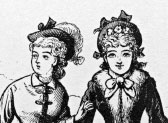The Etiquette ExhibitThe Lost Museum Archive

The early nineteenth century was a time of profound change in American society. Young people, primarily young men, poured into cities at unprecedented rates (and ever younger ages) in the first half of the nineteenth century, and a concurrent decline of the apprenticeship system eroded the customary authority of fathers and masters. In the anonymity of urban life, the traditional social controls of small communities gave way to a world where appearances often counted for more than reality. Tales of “confidence men,” abounded, warning urban residents about tricksters who used self-aggrandizement to exert influence and rise to authority. Urbanization and industrial modes of production were also accompanied by a rise in income inequality, and an increase in work that did not require manual labor. A new and growing middle class appeared in American cities, with distinctly middle-class neighborhoods, voluntary associations, and methods of child rearing. Thanks to improvements in technology and transportation, this period also witnessed the rise of large book publishers that could distribute their books more widely than ever before. According to historian Karen Halttunen, approximately 70 American etiquette manuals were published between 1830 and 1860, and many went through several editions. These etiquette manuals further helped to engender a shared middle-class identity by holding out the promise of republican society—that social respectability was not dependent on money alone but could be achieved by learning the proper manners. In an urban setting full of strangers, these manners fulfilled a vital, although not infallible, role—for how could anyone know for certain what lay behind the mask of etiquette?